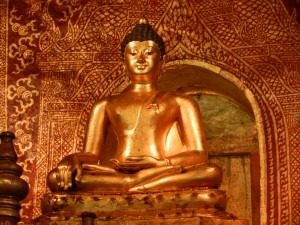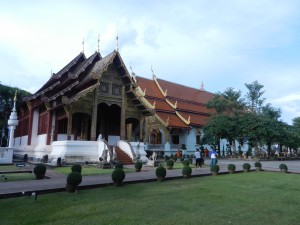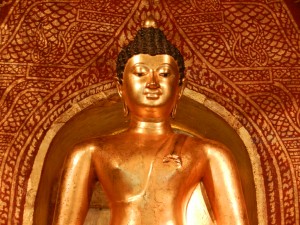The Kingdom of Lan Na emerged when the Thais liberated themselves from the Khmers in the 13th century. Lan Na thrived in northern Thailand, and it created some of the world’s greatest art.
Lan Na enjoyed its heyday in the late 15th century, so it created this art when Italians developed works that Westerners have taken for granted as the most beautiful. So Lan Na art is a great medium for exploring another culture’s way of looking at the world.
Lan Na’s environment is mountainous. It’s not dominated by one great river, like the Mekong or the Chao Phraya. Instead, several deep valleys finger southwards. They enjoy moderate climates–the sun doesn’t hammer you with its energy until you wilt.
Lan Na’s people thus lived in a land that was more human scale than sensational (Angkor’s is the latter). A legend says that monks in Chiang Mai in the 15th century felt that Sukhothai art was too dreamy, so they decided to return Buddhist sculpture to its pure forms. Scholars don’t agree whether the Sukhothai or Phra Singh style emerged first. but Lan Na artists fashioned the second type all over the kingdom, and mixed its features with Sukhothai’s.
The Phra Singh Buddha is earthier than the Sukhothai Buddha’s super-refined forms. Its fleshy face impressed me the most. It’s a bit chubby, but not enough to diminish the statue’s dignity. Solidity is conveyed by the face’s squarish shape–the Sukhothai’s is more oval. But it’s not a perfect square–the cheeks and chin slightly curve and become round in the corners. This blend of a square and round shape gives the face both sturdiness and softness.
A little double chin as pinchable as a baby’s projects from the bottom. This motherly tenderness is balanced by the large masculine hair curls on top of the head (Sukhothai curls are small).
The Phra Singh statue’s body also balances the Buddha’s compassion and firm will. It’s chest is broad and the arms are shorter and thicker than the Sukhothai’s. But the arms are rounded and smooth, rather than muscled like the beefcake Florentine sculptors were portraying. The Buddha has been meditating, and he’s calling the earth as witness just before achieving enlightenment. Sihingh means lion in Pali. But this regal soul with an iron will is also a gentle man that people can relate to.
Thai art doesn’t stress abstract lines and shapes, like classical Western art does. It uses flowing forms and glimmering colors to project energies and make them benevolent. But some of it becomes too fantastic for some people’s tastes. Lan Na brought Thai forms back to real world. It blends the spiritual and earthly realms as well as any culture’s art I’ve ever explored. We’ll examine more of its treasures soon.





Comments on this entry are closed.